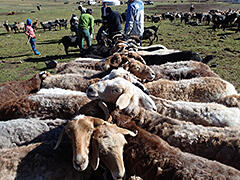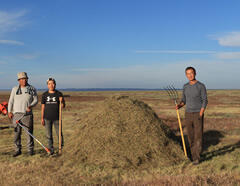Restoration of Pastureland by Effective Usage of Wild Forage Plants based on Traditional Knowledge of Nomadic Mongolians
Principal Investigator


Prof.
National University of Mongolia, School of Engineering and Applied Science
Javzan BATKHUU
ODA Recipient Country
Mongolia
Research Institutions in Japan
The University of Tokyo / Kyoto University / Tohoku Medical and Pharmaceutical University / National Agriculture and Food Research Organization
Research Institutions in Counterpart Country
National University of Mongolia / Mongolian University of Life Sciences (Research Institute of Animal Husbandry / Institute of Veterinary Medicine (IVM) / Center for Ecosystem Studies (CES)) / Ministry of Food, Agriculture and Light Industry / SHINE ANGIRT Co., Ltd / MONOS Group Company
Adoption fiscal year
FY 2019
Research Period
5 Years
Overview of the Research Project
Using traditional knowledge of nomadic Mongolians to maintain the health of livestock and restore Mongolia’s degraded grasslands
This project gathers the rich knowledge and oral traditions of nomadic Mongolians regarding Mongolian grassland flora’s effectiveness in restoring livestock health and degraded grasslands, selects useful grassland flora, and scientifically demonstrates their usefulness by investigating the chemical compounds and new genes that give them their restorative effectiveness. It also preserves grasslands and livestock health using grassland flora that grows well and is effective in maintaining good health by ‘diagnosing’ exhausted Mongolian grasslands and ‘treating’ them by establishing and deploying methods of cultivation for the selected flora.
Improving livestock farming productivity through more extensive use of pasture that is resistant to climate change and maintains good health
This project will develop the pastoral livestock farming industry through restoration of degraded Mongolian grasslands that have been improved through the scientific use of traditional knowledge of nomadic Mongolians and the spread of grassland flora that improves the productivity of grasslands degraded by overgrazing and contributes to livestock health. The application of this methodology will contribute to the revitalization of nomadic pastoral industries facing similar issues around the world.
Photo gallery
Research Project Web site
Press Release
Links
Projects
Contact Us
Japan Science and Technology Agency (JST)
Department of International Affairs
SATREPS Group
TEL : +81-3-5214-8085
Related articles by Category
- Bioresources
Bioresources

 Republic of Indonesia
Republic of Indonesia
Promoting the blue economy by utilizing seaweed resources!
Development of Sustainable Seaweed Based Functional Products for Promoting Blue Economy
- Mongolia
Infectious Diseases Control

 Mongolia
Mongolia
Protect Livestock in Mongolia from Protozoan Diseases and Ticks
Epidemiological Studies on Animal Protozoan Diseases in Mongolia and Development of Effective Diagnostics Measures
- Asia
Environment / Energy
(Global-scale environmental issues)
 Kingdom of Thailand
Kingdom of Thailand
“Natural rubber seeds”, the unlimited potential hiding in natural rubber plantations
Utilization Technology of Rubber Seeds for Green Products to Mitigate Global Warming and Plastic Pollution
- SDGs : Goal.2
Bioresources

 Republic of Indonesia
Republic of Indonesia
Achieve sustainable vegetable production in tropical regions using advanced breeding technology!
Breeding Innovation in Chili Pepper and Tomato to Accelerate Sustainable Vegetable Production in Tropical Regions


























